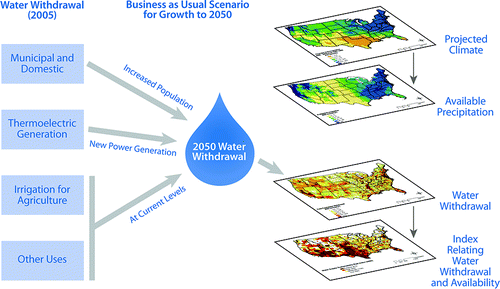More than 1 in 3 counties in the United States could face a "high" or "extreme" risk of water shortages due to climate change by the middle of the 21st century, according to a new study in ACS's Journal of Environmental Science & Technology. The new report concluded that 7 in 10 of the more than 3,100 U.S. counties could face "some" risk of shortages of fresh water for drinking, farming and other uses. It includes maps that identify the counties at risk of shortages.
In the analysis, Sujoy B. Roy, Ph.D., and colleagues explain that population growth is expected to increase the demand for water for municipal use and for electricity generation beyond existing levels. Global climate change threatens to reduce water supplies due to decreased rainfall and other factors compared to levels in the 20th century. Roy's group developed a "water supply sustainability risk index" that takes into account water withdrawal, projected growth, susceptibility to drought, projected climate change and other factors in individual U.S. counties for the year 2050. It takes into account renewable water supply through precipitation using the most recent downscaled climate change projections and estimates future withdrawals for various human uses.
Roy's team used the index to conclude that climate change could foster an "extreme" risk of water shortages that may develop in 412 counties in southern and southwestern states and in southern Great Plains states. "This is not intended as a prediction that water shortages will occur, but rather where they are more likely to occur, and where there might be greater pressure on public officials and water users to better characterize, and creatively manage demand and supply," Roy said.
More information: Projecting Water Withdrawal and Supply for Future Decades in the U.S. under Climate Change Scenarios, Environ. Sci. Technol., Article ASAP. DOI: 10.1021/es2030774
Abstract
The sustainability of water resources in future decades is likely to be affected by increases in water demand due to population growth, increases in power generation, and climate change. This study presents water withdrawal projections in the United States (U.S.) in 2050 as a result of projected population increases and power generation at the county level as well as the availability of local renewable water supplies. The growth scenario assumes the per capita water use rate for municipal withdrawals to remain at 2005 levels and the water use rates for new thermoelectric plants at levels in modern closed-loop cooling systems. In projecting renewable water supply in future years, median projected monthly precipitation and temperature by sixteen climate models were used to derive available precipitation in 2050 (averaged over 2040–2059). Withdrawals and available precipitation were compared to identify regions that use a large fraction of their renewable local water supply. A water supply sustainability risk index that takes into account additional attributes such as susceptibility to drought, growth in water withdrawal, increased need for storage, and groundwater use was developed to evaluate areas at greater risk. Based on the ranking by the index, high risk areas can be assessed in more mechanistic detail in future work.
Provided by American Chemical Society





















